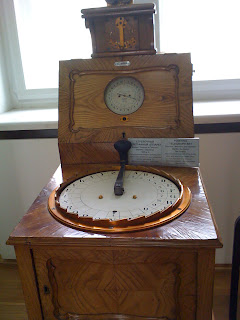Tucked on a street of posh boutiques, a gloomy archway leads into a courtyard strung with barbed wire and hung with huge portraits of victims of the GULAG, or Soviet labor camp.
 |
| Outside the Gulag History Museum |
The sign beneath the portraits reads: THESE ARE 12 OF MANY MILLION . . ., referring to the millions of Soviet citizens who passed through labor camps. Most were punished for political crimes, often only imagined by a paranoid Communist leadership. Many were killed or tortured. Those who survived usually faced repression and discrimination for the rest of their lives, as did their families. The Moscow city government runs this museum, one of the city's newest.
 |
| Gulag Museum |
 |
| The former USSR |
 |
| Stalin times - paintings. |
 |
| Gulag Museum | | | | | |
|
|
|
Outside Russia, the legacy of Stalin, who ruled as a dictator from the 1920s until his death in 1953, is pretty clear. Killing millions of his own people landed him in the pantheon of the world's worst dictators, alongside Hitler His name conjures images of domestic terror, nighttime arrests and prompted fatal campaigns against perceived enemies. However inside Russia, the story is more complicated. He was, according to recent books (printed 2010-2011) and endorsed by Prime Minister Vladimir Putin, a "competent manager" who committed atrocities at home out of necessity. Earlier this year, Stalin nearly won a nationwide call-in poll asking people to vote for the person who best represents Russia. The Gulag Museum tells a different story.The entrance mimics the gates of an average labor camp. Inside, scores of documents detail the Soviet leadership's decision to set up the prison network to purge society of perceived enemies and provide a free workforce for the massive infrastructure projects that would industrialize the nation.
There are boots and chains from Magadan, the site of Russia's most notorious camp. One wall is devoted to the tale of Georgiy Zhzhyonov, a famous Soviet actor imprisoned for speaking to an American on a train. Another is devoted to Bulat Okudzhawa, Russia's Bob Dylan, who lost most of his family to dreaded Gulag system. The museum is devoted to the people who suffered in the camps, for no reason.Gives you a real insight into recent Russian history.














































